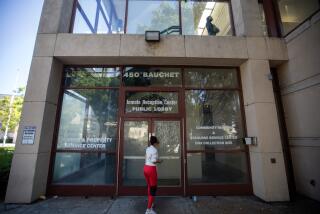Officials Urge Support for New Santa Monica Police Facility
- Share via
Santa Monica’s Public Safety Building, which houses the Police Department and jail, is neither safe nor accessible to the public, according to city officials.
Police and fire department chiefs and other supporters of a November ballot measure to help fund a new facility listed building problems at a press conference and tour of the facility Tuesday.
Educational, environmental and business representatives of a recently formed group called “Santa Monicans for Public Safety 1st” also expressed their support for funding a new facility.
“We’ve done everything we can to fit and cram and squeeze everyone into the building,” said Santa Monica Police Chief James T. Butts Jr. “Last weekend with the blackout we were running around with candles. The facility has outgrown its usefulness in terms of conventional police practices.”
More than 450 employees--about three times the number the facility was built for in 1957-- operate from the two-story building in the 1600 block of Main Street. Sewage sometimes backs up in pipes and drips from light fixtures, officials said. The women’s locker room floods during the rainy season.
And it’s not just an issue of comfort for building employees, Butts said.
Lack of a “sally port,” or confined area to transfer prisoners from a police vehicle to the jail, has resulted in the escape of five suspects, all of whom were eventually recaptured.
Where more modern police buildings use a walk-in room to store blood samples, the city building offers a household refrigerator.
The existing facility also does not meet seismic codes or comply with the Americans With Disabilities Act, Butts said.
The November ballot measure authorizes the city to issue up to $29.5 million in bonds to finance the construction of a public safety building.
City Councilwoman Pam O’Connor said she is confident the ballot measure will pass. “We have a broad spectrum of backers . . . police and fire departments, rent and school board members, youth groups and residents.”
More to Read
Sign up for Essential California
The most important California stories and recommendations in your inbox every morning.
You may occasionally receive promotional content from the Los Angeles Times.










